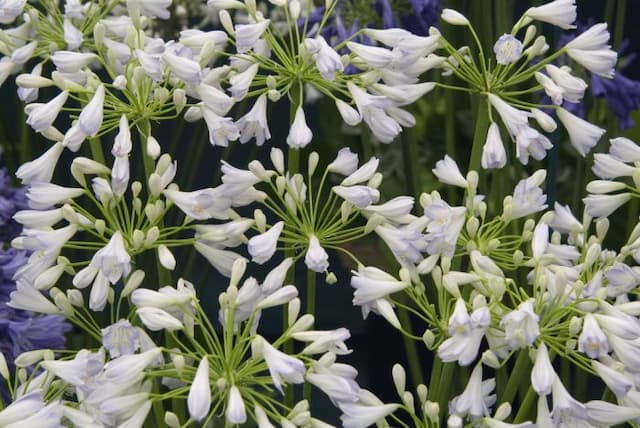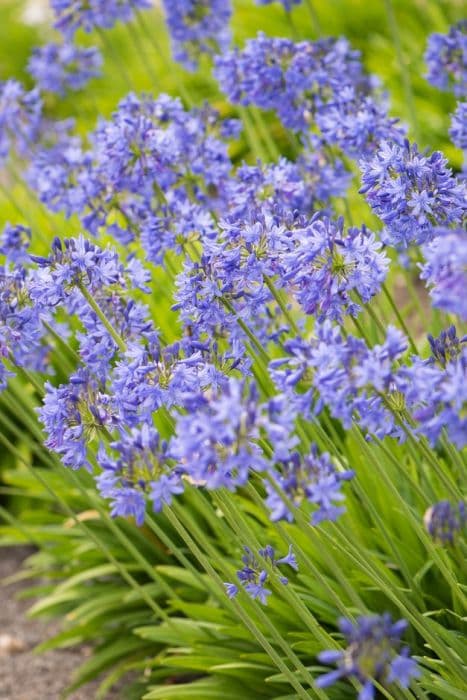Lily of the Nile Agapanthus 'Gletsjer'

ABOUT
The Agapanthus 'Gletsjer', commonly known as the Lily of the Nile or African Lily, is a perennial plant renowned for its striking appearance. This plant bears lush, strap-like green leaves that gracefully arch outward, creating a fountain-like effect. These leaves provide a lush backdrop for the most captivating feature of 'Gletsjer': its flowers. The bloom clusters of the Lily of the Nile 'Gletsjer' are particularly splendid, presenting as large, rounded umbels perched atop tall, sturdy, and erect stalks that rise conspicuously above the foliage. The flowers are usually a pristine white, radiating purity and elegance. Each individual bloom within the cluster is funnel-shaped, with smooth petals that softly recurve, giving the blossoms a slightly bell-like form. The blossoms of Agapanthus 'Gletsjer' are known for their extended blooming period, often adorning the plant with their delicate beauty throughout the summer months. As the plant matures, the clumps of foliage become more impressive, and the number of flower stalks multiplies, creating a more dramatic display. The overall appearance of the Lily of the Nile 'Gletsjer' is one of lushness and refined beauty, making it a popular choice for ornamental gardens.
About this plant
 Names
NamesFamily
Amaryllidaceae.
Synonyms
African Lily, Lily of the Nile, Love Flower.
Common names
Agapanthus 'Gletsjer'
 Toxicity
ToxicityTo humans
The Agapanthus, commonly known as Lily of the Nile, is known to contain compounds that can cause mild to moderate toxicity if ingested by humans. Symptoms of poisoning can include nausea, vomiting, and diarrhea. In some cases, skin contact with the sap can cause irritation or dermatitis. It is advisable to handle the plant with care and ensure that it is not consumed.
To pets
Lily of the Nile is also toxic to pets such as dogs and cats. If ingested, the plant can cause symptoms like vomiting, diarrhea, abdominal pain, and sometimes excessive salivation or drooling. It is important to keep this plant out of reach of pets to avoid any accidental ingestion, and to seek veterinary care immediately if you suspect your pet has consumed any part of the plant.
 Characteristics
CharacteristicsLife cycle
Perennials
Foliage type
Evergreen
Color of leaves
Green
Flower color
White
Height
2 feet [60 cm]
Spread
2 feet [60 cm]
Plant type
Bulb
Hardiness zones
9
Native area
South Africa
Benefits
 General Benefits
General Benefits- Easy to Care For: Agapanthus 'Gletsjer', commonly known as the Lily of the Nile, is relatively undemanding and easy to maintain, making it ideal for gardeners of all skill levels.
- Drought Tolerant: Once established, these plants are fairly drought-tolerant, requiring minimal watering which is beneficial in arid regions or during water-restriction periods.
- Attracts Pollinators: The flowers of the Lily of the Nile are attractive to pollinators like bees and butterflies, which is beneficial for the overall health of your garden and local ecosystem.
- Long Blooming Period: Agapanthus 'Gletsjer' has a long flowering period, usually from summer to early fall, providing a lengthy display of blooms.
- Landscape Versatility: They can be planted in borders, containers, or as a focal point in the garden, offering various landscaping options.
- Perennial Growth: As a perennial, Agapanthus 'Gletsjer' returns each year, saving the gardener time and money on annual plantings.
- Architectural Interest: The tall flower stalks and spherical bloom clusters add vertical and architectural interest to garden designs.
- Color Accent: The vibrant blue flowers add a delightful splash of color to garden palettes.
- Soil Adaptable: Agapanthus 'Gletsjer' can adapt to a variety of soil conditions as long as there is good drainage.
 Medical Properties
Medical PropertiesThis plant is not used for medical purposes.
 Air-purifying Qualities
Air-purifying QualitiesThis plant is not specifically known for air purifying qualities.
 Other Uses
Other Uses- Agapanthus 'Gletsjer' can be used in floral art and arrangements for their striking blue blooms, offering a strong visual element to any composition.
- In colder climates, as an indoor potted plant, the Agapanthus 'Gletsjer' provides a touch of summer hues to the indoors during winter months.
- The long and sturdy stems of Agapanthus 'Gletsjer' can be used for natural craft materials, such as in basket weaving or as part of handmade wreaths.
- Agapanthus 'Gletsjer' is often planted in mass to prevent soil erosion on slopes, thanks to its root structure that holds soil in place.
- The flowers can be used as a natural dye source, producing various shades of blue and purple for fabrics or artworks.
- As a teaching tool in botany and horticulture classes to demonstrate plant structure, propagation, and the lifecycle of a perennial.
- When dried, the seed pods from Agapanthus 'Gletsjer' can be used in decorative dry arrangements or for craft projects, as they maintain an interesting shape and texture.
- The plant can serve as a natural fencing or border in gardens, providing both privacy and aesthetic appeal with its tall flowering spikes.
- For photographers and painters, Agapanthus 'Gletsjer' serves as an inspiring subject thanks to its architectural form and rich color.
- In urban landscaping, it is used to beautify roundabouts and roadside borders, enhancing the greenery within town and city environments.
Interesting Facts
 Feng Shui
Feng ShuiThe African Lily is not used in Feng Shui practice.
 Zodiac Sign Compitability
Zodiac Sign CompitabilityThe African Lily is not used in astrology practice.
 Plant Symbolism
Plant Symbolism- Love Letters: The Agapanthus, commonly known as Lily of the Nile or African Lily, gets its name from Greek words 'agape' meaning love, and 'anthos' meaning flower, symbolizing love letters or a message of love.
- Beauty: With its striking blue to violet flowers, the Lily of the Nile represents beauty and elegance, making it a popular choice in ornamental gardens.
- Fertility: In some cultures, the prolific blooming of the Agapanthus is associated with fertility and abundance.
- Enduring Love: The sturdy nature and long-lasting blooms of the Lily of the Nile symbolize enduring and long-term love.
- Protection: In traditional lore, the Agapanthus is believed to offer protection against evil spirits, due to its toxic properties which deter pests and wildlife.
 Water
WaterAfrican Lily should be watered regularly during the growing season, about once a week, with a thorough soaking so that the water reaches deep into the root zone. During hot spells, you might need to water every few days, adding up to 2 gallons per week depending on the size of the plant and the heat intensity. In the winter, reduce watering to every few weeks, just enough to prevent the soil from drying out completely. Ensure good drainage to prevent root rot, as standing water is detrimental to the plant's health.
 Light
LightAfrican Lily thrives best in full sun conditions but can tolerate partial shade. Ideally, place it in a spot where it can receive at least 6 hours of direct sunlight daily. If grown indoors, a south-facing window is a suitable location for this plant to ensure it gets adequate light.
 Temperature
TemperatureAfrican Lily prefers a temperature range between 50°F and 80°F to flourish. It is hardy in zones 8 through 11 and can survive minimum temperatures as low as 20°F for brief periods, but prolonged exposure to freezing temperatures can damage the plant. Ideal growing conditions are warmer temperatures during the growing season and cooler temperatures in the dormant winter period.
 Pruning
PruningPrune African Lily mainly to remove spent flower stalks and any damaged or dead foliage. This helps direct the plant's energy toward producing new growth and flowers. Pruning is best done after flowering, typically in late summer or early fall. Regular deadheading throughout the blooming season helps to maintain the plant's appearance and may encourage additional blooms.
 Cleaning
CleaningAs needed
 Soil
SoilLily of the Nile thrives in a well-draining soil mix composed of loamy or sandy soil, amended with organic matter such as compost or well-rotted manure. A soil pH of 6.0 to 8.0 is generally suitable for healthy growth and flowering.
 Repotting
RepottingLily of the Nile should be repotted every 2 to 3 years, or when it becomes root-bound. This timeframe ensures sufficient space for root growth and nutrient absorption.
 Humidity & Misting
Humidity & MistingLily of the Nile prefers moderate humidity levels but is quite adaptable and can tolerate the varying humidity conditions typically found in outdoor environments.
 Suitable locations
Suitable locationsIndoor
Place in bright indirect light; keep soil moist, not wet.
Outdoor
Plant in sunny spot, shelter from strong winds, well-draining soil.
Hardiness zone
6-10 USDA
 Life cycle
Life cycleAgapanthus 'Gletsjer', commonly known as African Lily, starts its life as a seed, which upon germination develops into a small seedling. As it grows, the seedling develops fleshy roots and a clump of strap-shaped leaves, entering the vegetative stage. Over time, the plant matures and produces tall flowering stalks, which is its reproductive stage, usually beginning in early summer and lasting several weeks. After pollination, typically by insects, the flowers develop into seed pods that eventually dry and release seeds, thus completing the cycle. In colder climates, the plant may die back to the ground in winter, entering a period of dormancy, before resuming growth in spring from its fleshy rootstock. African Lily can also propagate vegetatively through division of the rootstock, thereby skipping seed production and creating a new plant that is a clone of the parent.
 Propogation
PropogationPropogation time
Spring-Early Summer
Agapanthus 'Gletsjer', commonly known as Lily of the Nile, is most commonly propagated by division. The best time to divide this plant is in the spring or early fall. To propagate by division, gently lift the clump from the soil and use a sharp knife or spade to separate it into smaller sections, each with at least one or two healthy shoots. It is important to ensure that each section has a portion of the root system attached. After division, the plant sections can be replanted into well-drained soil, ensuring that they are not set deeper than they were originally growing. Water the newly planted divisions thoroughly to help establish them.









